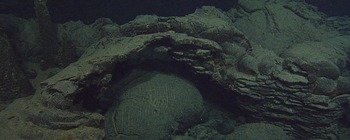Geology of ASHES Vent Field Topic Summary
Topic Summary
A tentative title for my project is “Using Sea Floor Imagery to Determine the Geologic Setting of ASHES Vent Field.” The goal of this project is to examine the geologic setting of ASHES vent field on Axial Seamount, Juan de Fuca Ridge to test two hypotheses. The first hypothesis is that the ASHES vent field was created by the collapse of a magma chamber during lava drainback creating a collapsed basin. The second hypothesis is that the vent field basin is sea floor surrounded by more recent lava flows from Axial Seamount. Models by Butterfield et al (1990) suggest that the hydrothermal field is fed by fluids migrating up a zone of high permeability beneath ASHES vent field. Measurements by Gilbert et al (2007) have determined the sea floor around axial seamount to be porous with low density consisting of both large lava drain backs and open pillow basalts. Recent seismic topographic mapping has confirmed the existence of a pool of partial melt 1-2.5 km below the Axial Seamount caldera (West et al. 2003; Canales et al. 2009). Close examination of the geology in and around ASHES vent field will provide insight as to how the vent field was formed and what drives its venting. Adobe Photoshop will be used to photomosaic thousands of images into high resolution bathymetry cross sections of ASHES vent field basin walls. To accomplish this task, bathymetry from the robotic vehicle ROPOS will be downloaded to hard disk in the form of high definition images from a Zeus Plus high definition camera. After the images and video have been obtained, they will be processed through Adobe Photoshop to create high resolution cross sections of the basin walls. The images will then be analyzed to determine whether ASHES vent field was created by the collapse of a magma chamber or surrounded by lava flows built up over time. If the images reveal mostly intact lava flows as basin walls then AHSES vent field is sea floor surrounded by more recent lava flows from Axial Seamount. If the images reveal near vertical walls with jagged edges, then ASHES vent field was created by the collapse of a magma chamber during lava drainback. However, jumbled sheet flows with rubbly surfaces are not indicative of lava drainback (Hammond 1990). Determining the geologic setting of ASHES vent field will further understanding of geological controls on vent distribution and serve as a base for further investigation into geological studies of ASHES vent field (Hammond 1990). These images will be taken along the Axial Seamount and Ashe’s Vent Field 250 miles off the Oregon coast. This study will be completed on the Visions’11 cruise from August 19, 2011 to September 1, 2011. These operations will be supervised and administered by Dr. Deborah Kelley and Dr. John Delaney.
References
Butterfield, D. et al. 1990. Geochemistry of Hydrothermal Fluids From Axial Seamount Hydrothermal Emissions Study Vent Field, Juan de Fuca Ridge: Subseafloor Boiling and Subsequent Fluid-Rock Interaction. Journal of Geophysical Research. 95: 12895-12921.
Canales, J. et al. 2009. Sesmic reflection images of a near-axis melt sill within the lower crust at the Juan de Fuca ridge. Nature. 460: 89-93. doi: 10.1038/nature08095
Gilbert, L. et al. 2007. Porosity of the upper edifice of Axial Seamount. Geological Society of America. 35: 49-52. doi: 10.1130/G22892A.1
Hammond, S. 1990. Relationships Between Lava Types, Seafloor Morphology, and the Occurrence of Hydrothermal Venting in the ASHES Vent Field of Axial Volcano. Journal of Geophysical Research. 95: 12875-12893.
West, M. et al. 2001. Magma storage beneath Axial volcano on the Juan de Fuca mid-ocean ridge. Nature. 413: 833-836.


